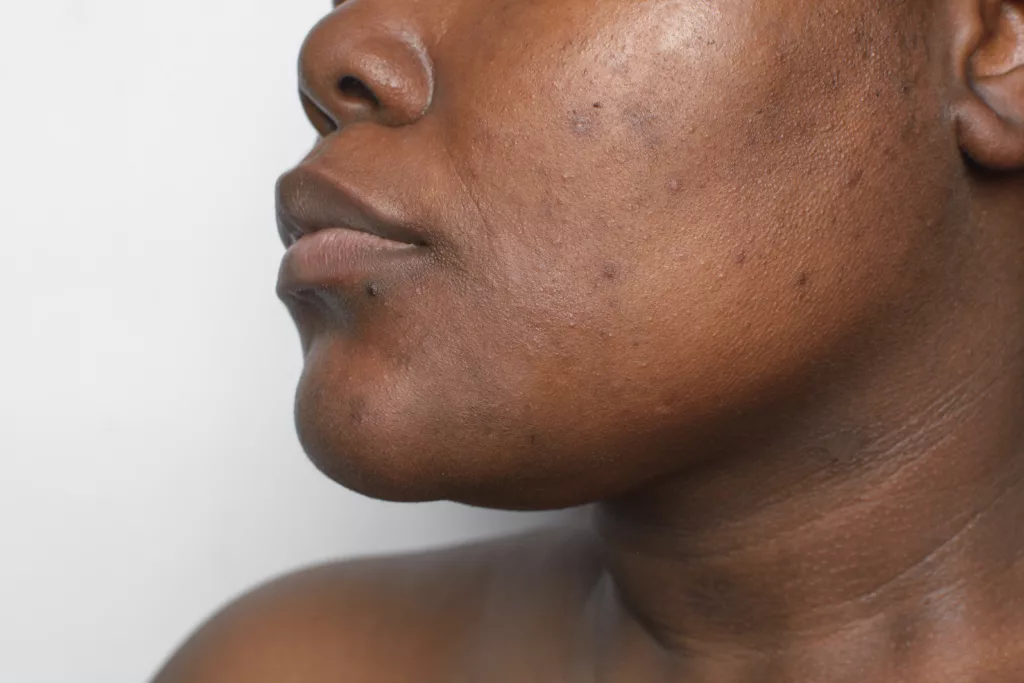
Does Microneedling Help Melasma? let’s find out this informative post.
Melasma is an incredibly common skin condition, especially among women. It manifests as dark patches around the face, often triggered by hormones or prolonged sun exposure.
Melasma patches typically appear on the cheeks, forehead, upper lip, and chin, resembling a mask-like pattern. This pattern — combined with its common occurrence among pregnant women — led to the condition often being referred to as the “mask of pregnancy.”
While it is not dangerous or harmful, melasma can cause significant cosmetic concern and emotional distress.
However, as common as it may be, there is still no definitive cure for melasma. However, there are several treatment strategies that can effectively manage this condition. These range from simple prescription or topical medications to cosmetic procedures, such as laser therapy.
One potential treatment option for melasma that is gaining attention recently is microneedling.
What Is Microneedling?
Microneedling — also known as collagen induction therapy — is a minimally invasive procedure that involves the use of a device equipped with fine needles. These needles are used to create controlled micro-injuries in the skin. This process triggers the skin’s natural healing response, stimulating collagen and elastin production. These two are the key components contributing to the skin’s firmness, texture, tone, and overall appearance.
Today, microneedling is commonly used to improve skin texture, reduce scars, and minimize wrinkles. It also shows great potential as a melasma treatment.
Does Microneedling Help Melasma
Available studies on melasma and microneedling have reported promising outcomes, such as the 2015 study published in the journal Anais Brasileiros De Dermatologia. It demonstrated improvements in melasma pigmentation and overall skin appearance after microneedling treatments.
The concept of using microneedling to treat melasma is rooted in its ability to stimulate collagen production and enhance the penetration of topical products. Microneedling offers the following potential benefits that make it an intriguing option for managing melasma:
- Increased Product Penetration: Microneedling creates tiny channels in the skin, allowing topical treatments to penetrate more effectively. This can enhance the delivery of depigmenting agents, such as hydroquinone or vitamin C, which are often used to treat melasma.
- Collagen Induction: The tiny holes created by the microneedles encourage that part of the skin to create more collagen. In turn, the new collagen-rich skin area leads to a more even skin tone and texture.
- Elastin Production: Additionally, elastin produced as a result of microneedling contributes to better skin elasticity and reduced marks or wrinkles for a plump and youthful look.
- Stimulation of Melanocytes. Microneedling’s controlled injury mechanism may also influence melanocyte activity, the cells responsible for producing melanin. This modulation could lead to a more balanced distribution of melanin and reduced pigmentation irregularities.
- Triggering Skin Renewal.The controlled micro-injuries induced by microneedling prompt the skin to initiate a renewal process, potentially leading to the shedding of hyperpigmented cells and the growth of healthier, more evenly pigmented skin.
Supporting Microneedling Treatments
In general, microneedling treatments are performed along with other treatment strategies. Due to its benefits in increasing topical product penetration, it is often used with products like hydroquinone, which are proven effective with lightening skin marks like melasma. With other cases, microneedling is done in conjunction with other procedures like IPL laser therapy.
Moreover, it is necessary to ensure proper skin care following microneedling for melasma. This includes using sunscreen with high SPF regularly and staying in the shade whenever possible.
The Bottom Line
Melasma can be a persistent and challenging condition to address, often requiring a multifaceted approach. Microneedling holds potential as a valuable addition to the melasma treatment toolkit.
However, it is essential to consult with a licensed dermatologist before embarking on any treatment journey. They can assess the individual’s condition, provide personalized recommendations, and create a tailored treatment plan that may include microneedling along with other complementary therapies.
Moreover, it is best to entrust the treatment to qualified professionals, instead of simply doing a DIY microneedling treatment at home using commercial products.
If you are interested in learning more about microneedling and how it may help with your melasma, reach out to us today.

